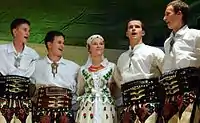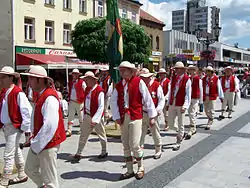Gorals
The Gorals (Polish: Górale; Slovak: Gorali; Cieszyn Silesian: Gorole; literally "highlanders") are an ethnographic (or ethnic) group primarily found in their traditional area of southern Poland, northern Slovakia, and in the region of Cieszyn Silesia in the Czech Republic (Silesian Gorals). There is also a significant Goral diaspora in the area of Bukovina in western Ukraine and in northern Romania, as well as in Chicago, the seat of the Polish Highlanders Alliance of North America.
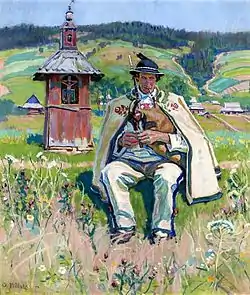
Population
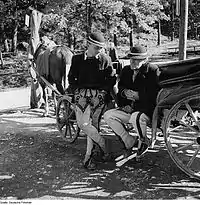

In Poland, the community inhabits the geographical region of Podhale of the Tatra Mountains and parts of the Beskids (Cieszyn Silesia, Silesian Beskids, Żywiec Beskids). After 1945 when the Germans were expelled from the so-called Recovered Territories, some Górals from Bukovina and the Podhale regions found new homes in Lower Silesia in villages such as Krajanów, Czarny Bór, and Borówna in the Central Sudete Mountains, as well as Złotnik, Brzeźnica and Lubomyśl in Lubusz Voivodeship.
In present-day Slovakia they live in 4 separate groups: in northern Spiš (34 villages subdivided in two groups), Orava and Kysuce (2 villages) and smaller groups in 7 other enclave villages in northern Slovakia.
The main settlements of Gorals include:
Language
The West Slavic, Polish dialects spoken by the Gorals share many linguistic features with neighboring East Slavic languages spoken by other Carpathian highlanders, especially the Rusyn language spoken by the Hutsuls, Lemkos, and Boykos.
The various dialects spoken by the Gorals descend from Proto-Slavic from the Eastern Lechitic, Old Polish area, superimposed by Slovak. In particular, the language of Podhale, called the Podhale dialect (Polish: gwara podhalańska), is of Polish origin, but has been influenced by Slovak[1] in recent centuries. It is a subdialect of the Lesser Polish dialect cluster. In addition to Polish, the language contains some vocabulary of other origins, including Slovak, Eastern Romance, and words of uncertain origin that have cognates in other languages of the Carpathian region.
Jabłonkowanie, a phonological feature similar to mazurzenie, occurs in some Silesian dialects. 14th- and 15th-century palatal consonant pronunciation (called "Podhale archaisms") features are preserved in the Podhale dialect.[2] K. Dobroslowski asserted that the Podhale dialect had loan-words from Romanian and Albanian (1938), as well as similar belief system elements, music and material culture.[3]
History
In the 16th and 17th centuries Gorals settled the upper Kysuca, Orava rivers, and part of northern Spiš.[4] These territories were part of the northern Kingdom of Hungary.[5] The mountainous regions were settled with pastoral Slavs with the "Vlach law".[5] In 1803–19, Gorals migrated to Bukovina.[6]
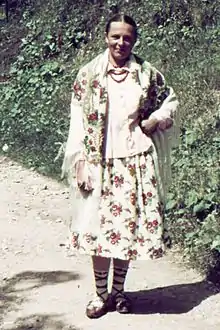
During World War II, Nazi Germany sought to Germanize the Gorals, along with the Estonians, Latvians and Lithuanians, and include them in the resettlement plans.[7] Under Nazi racial laws, the White Russians, Gorals and Ukrainians were viewed as "undesirable", and thus subject to special statutes (labour and police law) in the occupied territories of Eastern Europe, although to a milder degree than other non-German ethnic groups.[8] Nazi racial theorists considered the 27,000 strong Goral population as a separate ethnic group from the Poles.[9] Termed Goralenvolk, they were deemed part of the "Greater Germanic Race" and given separate treatment from other Poles.[10][11]
Anthropology
The Gorals and other West Slavic peoples of the Carpathians show little northern, Germanic, influence, as opposed to other regions of Poland.[12] Carleton S. Coon grouped the Gorals with the Hutsuls in the southeastern corner of Poland (now Ukraine).[13] In the 19th century, Polish scholars viewed the Gorals as linguistically close to the Poles, but having close ties with Slovak folk culture.[14] It was noted that Gorals' social and economic life resembled that of Vlach shepherd culture.[14]
In a wider sense Gorals refers to an ethnographic (or even ethnic) group comprising certain highlanders in the northern Carpathians, more precisely these ethnic groups:
- Gorals
- Żywiec Gorals (autonym: żywczaki, pl: górale żywieccy), of Żywiec Basin in Poland
- Silesian Gorals (autonym: gorole, pl: górale śląscy, cz: slezští goralé) of Cieszyn Silesia in Poland and Czech Republic
- Podhale Gorals (pl: górale podhalańscy) of Podhale in Poland
- Hutsuls (ukr: hutsuly) of Bukovina and Maramureş in Ukraine and Romania
- Lemkos (ukr: lemki, pl: łemkowie) of Lemkivshchyna in Poland, Slovakia, Ukraine
- Boykos (ukr: boyki, pl: bojkowie), in Ukraine, Poland, Slovakia
- Moravian Vlachs in Moravian Wallachia, Czech Republic
National identity
For most Gorals today, the decisive factor in their self-identification with a nationality is not ethnic but territorial. For example, those living in areas under a long tradition of belonging to the Polish state identify themselves as Polish, while those living in Slovakia have identified themselves as Slovaks, with notable exceptions to this rule on both sides of the border. While the origin of the Goral dialect is Polish,[15] the language of Gorals in Slovakia and in the Czech Republic is gradually shifting and increasingly becoming more similar to the literary standard in their respective countries. Silesian Gorals of the Czech Republic identify themselves on the nationality level as Poles and are members of the Polish minority in Zaolzie, which is proved by their communal activity – annual Gorolski Święto festival held in Jablunkov (Jabłonków) is a showcase of a local Polish Goral traditions and is organized by the PZKO (Polish Cultural and Educational Union). This Goral festival preserves the traditions of the Polish nationality group in Zaolzie.[16] It is the largest cultural and folklore festival in Zaolzie area gathering thousands of spectators each day of festivities.
However, in none of the towns and villages of the area the Poles form a majority and some local Gorals identify themselves on the nationality level as Czechs. In this respect the village of Hrčava (the second easternmost village in the Czech Republic), with vast majority of citizens declaring Czech nationality, can be mentioned. In this village the Poles form only a 2% minority.[17] Local Gorals formed (as indigenous people) a majority in the past. They speak the regional dialect in everyday communication.
Historically, the issue of their ethnic identity has been controversial and resulted in claims and counterclaims by both Poland and Czechoslovakia. Gorals, like many other peasant communities in Central Europe, determined their own ethnic identities within the nation state system during the 19th and early 20th century.[18] American anthropologists termed the Gorals "Black Russians", while noting that the western Gorals spoke Polish.[19] Although nationalist propaganda was generated by both Poles and Slovaks, this process of the Gorals' identification with a nationality was still not complete when the border was finalized in 1924. A notable example were Ferdynand Machay, a priest born in Jabłonka, Orava, Piotr Borowy from Rabča, Orava and Wojciech Halczyn from Lendak, Spiš, who went to the Paris Peace Conference, 1919 and, during a personal audience, lobbied U.S. president Woodrow Wilson to sign these lands over to Poland.
Culture
Architecture
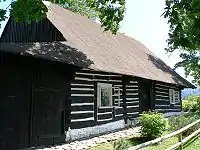
The Zakopane Style architecture, established at the end of the 19th century, is held as a Goral tradition. The architectural style draws on local architecture and Vernacular architecture of the Carpathians, and is widespread in the Podhale region.
Music

The Zakopower is a popular folk-pop musical group from Zakopane. The Trebunie-Tutki folk musical group from Zakopane blend traditional Goral music with reggae.
Clasps
For centuries clasps have been an important element of Polish highlanders’ traditional costumes. Originally used for fastening shirts, they fell out of use when buttons became popular, remaining only as ornaments. In the early 20th century they were already rare, used only by senior and young shepherds, who grazed their sheep on mountain pastures. In the 1920s and the 1930s they were considered collector's items and sought after by tourists. In Zakopane they were often worn as ornaments for the "cucha" (outerwear), sweaters or occasionally on leather bags. Today the clasps are a popular element of highlanders from the Podhale region, but the way they are worn differs from the original one: instead of fastening shirts they are usually attached to them or sewed on.[20]
Parzenica (embroidery)
The parzenica embroidery dates back to the mid-19th century. Initially they were simple string loops, used for reinforcing cuts in front of cloth trousers. They had practical functions and protected the cloth from fraying. The modern look parzenica got from those tailors who began using red or navy blue string, simultaneously increasing the number of loops. Later the appliqué design was replaced with embroidery. Using woollen yarn allowed the parzenica to become more colourful and eventually it became a stand-alone trouser ornamentation, developed by talented tailors and embroiderers.[21]
Corsets
In the second half of the 19th century it became fashionable in the Podhale region to adorn corsets with depictions of thistle and edelweiss. These motifs were the most popular in the early 20th century. When "Kraków style" came into fashion, highlanders of the Podhale region began ornamenting the corsets with shiny sequins and glass beads.[22]
Other
In Cieszyn Silesia and northern Slovakia, the Shepherd's axe and elements of the folk costume are termed Vlach (Polish: wałaska, wałaszczaki, Slovak: valaška).[23]
Highlanders Costumes in their collections have the following museums, e.g.: The National Museum of Ethnography in Warsaw,[24][25] The Tatra Museum in Zakopane, the Ethnographic Museum of Kraków, the City Museum of Żywiec
Religion
Gorals are adherents of the Roman Catholic Church and are often noted for their staunch religiosity.
The Sanctuary of Our Lady of Ludźmierz is of particular importance to the Gorals, being the oldest monument in the Podhale region. There are numerous cults connected to the church.
Notable people
- Tomasz Adamek – Polish boxer
- Alicja Bachleda-Curuś – Polish actress
- Stefan Banach – Polish mathematician
- Andrzej Dziubek – Polish-Norwegian musician
- Sebastian Karpiel-Bułecka – Polish singer
- Justyna Kowalczyk – Polish cross country skier
- Władysław Orkan – Polish writer
- Jan Kanty Pawluśkiewicz – Polish composer
- Józef Tischner – Polish priest and philosopher
- Tadeusz Błażusiak – Polish sport motorcyclist
- Jerzy Kukuczka – Polish alpinist
See also
- Gorani, a Slavic Muslim highlander people in Kosovo
References
- Nicolaas van Wijk (1931). Czechoslovakia: facts and impressions. Orbis. p. 37.
- The American Slavic and East European Review. 9. a committee of American scholars. 1950. p. 329.
- Alain Bertrand, Alain Karsenty, Antonio Carlos Santana Diegues, Arild Angelsen, Berry Lekanne dit Deprez, Brent M. Swallow, Bustanul Arifin, Carl Folke, Chusak Witthayaphak, David Feeny, El Hadj Laouali Mahamane, Frode Gundersen, Guangjing Ma, Hsain Ilahiane, International Association for the Study of Common Property, Irma Baquero, Janis B. Alcorn, João S. Campari, M. Kokwe, Madan Gopal Ghosh, Małgorzata Korzycka-Iwanow, Minoti Chakravarty-Kaul, N. S. Jodha, Nalin Ranjan Jena, Paul Kenkmann, Philippe Guizol, Piotr Chmielewski, Raouf Fareed Khouzam, Satyawati Soetrisno Hadi, Segun Famoriyo, Stig Toft Madsen, Søren Lund, Tatiana Levina, Theodore Macdonald, Tor Arve Benjaminsen, Tove Degnbol, Fikret Berkes, He Shang, Jacques Weber, Víctor Manuel Toledo (1995). Fifth Common Property Conference papers. International Association for the Study of Common Property. p. 163.CS1 maint: multiple names: authors list (link)
- Denes Loczy; Miloš Stankoviansky; Adam Kotarba (3 January 2012). Recent Landform Evolution: The Carpatho-Balkan-Dinaric Region. Springer Science & Business Media. pp. 149–. ISBN 978-94-007-2447-1.
- Karoly Kocsis; Eszter Kocsisne Hodosi (1 April 2001). Ethnic Geography of the Hungarian Minorities in the Carpathian Basin. Simon Publications LLC. pp. 45–46. ISBN 978-1-931313-75-9.
- Halina Karaś. "2.6. Gwary polskie za granicą".
- Martyn Housden (4 January 2002). Hitler: Study of a Revolutionary?. Routledge. pp. 138–. ISBN 978-1-134-71369-1.
- Diemut Majer (2003). "Non-Germans" Under the Third Reich: The Nazi Judicial and Administrative System in Germany and Occupied Eastern Europe with Special Regard to Occupied Poland, 1939-1945. JHU Press. pp. 533–. ISBN 978-0-8018-6493-3.
- Mark Levene (December 2013). Annihilation: Volume II: The European Rimlands 1939-1953. OUP Oxford. pp. 45–. ISBN 978-0-19-968304-8.
- "Pod Giewontem. Losy mieszkancow Podhala 1939-1956". Podhalański Portal Informacyjny Podhale24.pl. September 12, 2011. Retrieved April 21, 2012.
- "Historia rodziny Apostołów". Lista świadków historii (in Polish). Stowarzyszenie Auschwitz Memento. Archived from the original on January 23, 2015. Retrieved April 21, 2012.
- Norman John Greville Pounds (1969). Eastern Europe. Aldine Pub. Co. p. 67.
- carleton stevens coon (1939). the races of europe. p. 571.
- Marcel Cornis-Pope; John Neubauer (2010). History of the Literary Cultures of East-Central Europe: Types and stereotypes. John Benjamins Publishing. pp. 445–. ISBN 90-272-3458-2.
- For a better idea of the issue see either Kevin Hannan's work Borders of Language and Identity in Teschen Silesia or works by the Slovak linguist Júlia Dudášová-Kriššáková, Goralské nárečia, ISBN 80-224-0354-7
- "History of Gorolski Święto for foreign visitors". gorolskiswieto.cz. Retrieved 20 September 2019.
- "Czech Statistical Office (2001 census)". czso.cz. Retrieved April 10, 2017.
- Hannan, Kevin (1996). Borders of Language and Identity in Teschen Silesia. New York: Peter Lang. ISBN 0-8204-3365-9
- United States. Immigration Commission (1907–1910); William Paul Dillingham (1911). Reports of the Immigration Commission. U.S. Government Printing Office. p. 265.
- Uszyńska, Zofia (1960). Poland: Travel Guide. vol. 1. U.S. Government Printing Office.
- Pietraszkowa-Fryś, Ewa; Pokropek, Marian; Kunczyńska-Iracka, Anna (1991). Folk art in Poland. Arkady. p. 80. ISBN 9788321334783.
- Pietkiewicz, Kazimierz (1966). Polish Folk Art. Polonia Publishing House.
- Kevin Hannan (1996). Borders of Language and Identity in Teschen Silesia. Peter Lang. p. 70. ISBN 978-0-8204-3365-3.
- Czas świętowania w kulturach Polski i Europy. The State Ethnographic Museum in Warsaw. 2013. ISBN 978-83-88654-42-8.
- Bartuszek, Joanna; et al. (2008). Czyżewski, Adam (ed.). Ordinary - extraordinary : fascinating collections of The State Ethnographical Museum in Warsaw. The State Ethnographic Museum in Warsaw. ISBN 978-83-88654-76-3.
External links
![]() Media related to Gorals at Wikimedia Commons
Media related to Gorals at Wikimedia Commons
- Info-Portal Silesian Gorals in Polish
- Map showing the extent of Goral settlement
- An entry in Slovak
- Gorale – old photographs
- Goral dialect from linguistic point of view – covering several villages in Slovak part of Orava (in Slovak)
- Chicago Public Radio series on diaspora communities in Chicago, including one on Goral Music in Chicago
